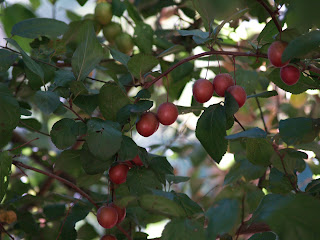Tuesday, July 24, 2007
All Prunes are Plums; All Plums aren't Prunes.
Who knew that plums could be so interesting? Those cloying globs of sticky laxative and those over-hard, under-sweet purple and red ones at your local grocer show little of what plums are capable of.
There are a few thousand types of plums in the world with nearly 150 cultivated in the US, while only 20 are regularly grown. With just a little bit of information a novice can separate the different varieties into their basic categories.
There is the globular, maroon and purple skinned, red fleshed Japanese Plum.
There is the slightly oblong, somewhat slender, purple skinned and fleshed European Plum.
There is the smaller, round, blue black Damson plum with its only semi-sweet green to golden yellow flesh, tart skin, and technical classification as a different species.
There is the Green Gage and Yellow Gage, that are named by the color of their skin and flesh.
And then there is another kind. One I wouldn't have even realized unless I happened to move into this house. In our yard are two Wild Plum trees. One produces lovely golden plums that are the same size as cherries and another that produces beautiful rose colored drupes that are closer to the diameter of an American quarter. These have delicate skins, juicy, sweet flesh and are about 1/3rd stone. We get two small harvests each year. The first comes early in July, when the golden fruit is ripe. The next is in mid to late August, when the rose fruit is ripe.
While the fruit isn't viable for a commercial product, because of its low yield and small fruits, it could be easy to grow for the home gardener. I haven't done a thing to mine and they are apparently disease free and healthy. The trees grow wild throughout most of the United States (not in the Panhandle and deserts, generally) and many of the trees have been creating their own groves. All you would need are two trees from the same genus (European plus European, Damson plus Damson, etc...) in order to have a few bucketfuls of fruit per year. European plums are the most prolific of all types and the wild ones are the least prolific.
Plums are amazing little powerhouses of nutrition too. They have a particularly potent super-oxide antioxidant that clobbers free-radicals, they help your body increase its absorption of iron and they are a good source of several nutrients. On average, two medium plums will provide you with 60 Calories, Zero Fat, Cholesterol and Sodium, 16 grams of Carbohydrates (6%), 2 grams of Fiber (8%), 228 IU of Vitamin A (10%), 6mg Vitamin C (20%) and 4 mcg Vitamin K (10%). (You can increase the fiber rating by choosing the European plums or prunes.)
And, lastly, you should know that all prunes are dried European plums and have a high sugar content. A dried plum is a plum that is cut in half and dried without the pit. The fruit called prunes are simply the slender European type.
I hope you get a chance to try some tree ripened plums from your local Farmers Market this week. Look out for the different sizes and colors available and find out what is so interesting about them for yourself as well.
Subscribe to:
Post Comments (Atom)




No comments:
Post a Comment